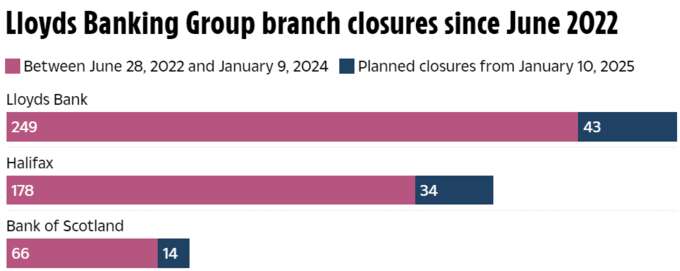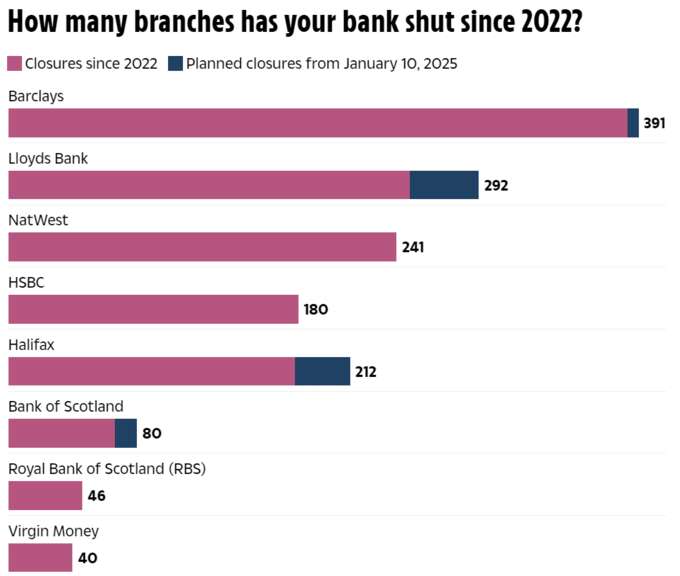
Lloyds Banking Group, owner of subsidaries Halifax and Bank of Scotland is making a huge changes to services across all its bank branches.
The banking giant has announced plans to enable customers to access services at any branch regardless of which brand they bank with.

For example, this means that a Lloyds Bank customer will be able to access the same services when visiting Halifax and Bank of Scotland branches, and vice versa.
While Lloyds claims this move will provide customers with "access to the UK’s biggest combined branch network" and greater flexibility, trade unions have expressed concerns that this is a precursor to widespread branch closures and job losses despite Lloyds Bank’s denials.
This announcement comes as Lloyds, like many other UK banks, is experiencing a significant shift towards digital banking.
Lloyds also stated that increasing its mobile app user base is a key priority, and highlighted the development of updated mobile apps for Halifax and Bank of Scotland.
However, unions have argued that the cross-brand branch access strategy is primarily motivated by cost-cutting and streamlining operations, rather than improving customer experience.
Mark Brown, general secretary of BTU, predicts that this change will enable Lloyds to quickly close approximately 233 branches, resulting in thousands of job losses.
Lloyds Bank disputes these claims, stating that BTU is not a recognised union and therefore lacks the necessary insights into the bank’s operations to make such predictions.
Since June 2022, Lloyds Banking Group has shut 493 bank branches across its three brands.
A further 91 branches are set to close in 2025.
The banking group currently operates out of 932 branches across the UK, according to trade union Accord.

A Lloyds Banking Group spokesperson said: "We’re always looking for ways to make banking easier and more flexible for our customers.
"From later this year, we’ll offer customers of Lloyds, Halifax and Bank of Scotland the option to use branches of any brand for their in-person banking, alongside our apps, mobile messaging, and telephone services."
What’s happening at other banks?
Customers are increasingly turning to online banking to manage their finances while banks and building societies look for ways to cut costs.
Since 2022, UK bank branches have seen widespread closures, with Barclays leading the way with 384, followed by HSBC (180), NatWest (241), and Lloyds Bank (249), according to ATM operator LINK.
Looking ahead to 2025, Halifax has the most planned closures (34), significantly more than Lloyds Bank (43), TSB (8), and Bank of Scotland (14).
Several banks, including HSBC, RBS and Nationwide have no current plans to close further branches in 2025.

What to do if your local bank is set to close
There are still a number of ways people can access basic banking services without having to venture to another town with a branch.
You can use one of the Post Office’s 11,684 branches to perform basic banking tasks — but not to open new bank accounts or take personal loans and mortgages.
You can find your nearest Post Office branch by visiting postoffice.co.uk/branch-finder.
Meanwhile, many banks offer a mobile banking service - where they bring a bus to your area offering services you can usually get at a physical branch.
Other banks use buildings such as village halls or libraries to offer mobile banking services.
It’s worth contacting your bank to see what mobile services they have available, and when they might next be in your area.
New super ATMs are being rolled out across the UK where branch closures have left residents unable to access essential banking services.
These ATMs will allow customers to withdraw funds, access their balance, change PIN numbers and deposit cash.
Bank of Scotland, Barclays, Halifax, Lloyds, NatWest, Royal Bank of Scotland and Ulster Bank are already signed up to allow deposits, at the super ATMs.
Banking hubs are also being opened across the UK with 250 set to be available by the end of 2025.
These sites typically feature a counter service operated by the Post Office as standard, enabling customers to conduct routine banking transactions conveniently.
Each hub also has a private area where customers can consult with staff representing their banks for more complex matters.